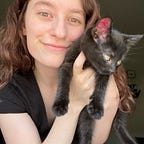Science Fiction and Knowledge
“It matters what ideas we use to think other ideas with. It matters what matters we use to think other matters with; it matters what stories we tell to tell other stories with; it matters what knots knot knots, what thoughts think thoughts, what ties tie ties. It matters what stories make worlds, what worlds make stories.
Donna Haraway shares this quote in her speech while accepting the Pilgrim Award from the Science Fiction Research Association. She talks in this speech about being inspired by both abstract ideas around her and by her strong scientific background, which is ultimately what led her to get into science fiction. She relates science fiction to the game of cat’s cradle, where children create certain patterns in string and pass it back and forth. She gets at the idea that this represents how knowledge is passed back and forth, and also how she writes her stories (Haraway). There is a lot of give and take, where she must take in information and relay it in a way that is intriguing, informational, and good for any audience. Science fiction combines the ideas of art and science, which allows for a greater audience and the opportunity to share scientific knowledge beyond the bounds of the scientific community.
In her speech at MIT, Octavia Butler gets at similar ideas on science fiction and her experience. She talks about how, in our modern world, we have access to lots of information very readily. The problem with that, which she gets at, is that we less often produce our own ideas and think through concepts in our own ways. She includes a quote from one of her novels that says “all too often, we say what we hear others say. We see what we are permitted to see. Much worse, we see what we’re told to see” (Parable of Talents). I think that this displays perfectly our modern ways of thinking, how what we see on the media and in speeches by public figures influences greatly what we think and how we act. She talks about how a lot of people are unable to read well, and how even more people don’t read on a regular basis in order to obtain knowledge on their own. They are relying more and more on what they hear to shape their ideas (Butler). Science fiction, however, is a way to bridge this gap that is actually enjoyable. Science fiction can include images and/or more easy-to-read stories that still tell a story of science. It portrays it in a way that is both enjoyable to read, but also gets messages across in a way that allows for interpretation and the creation of one’s own ideas.
Ted Chiang, in his science fiction writing Exhalation does just this. This is a story about refillable lungs and increasing air pressure that doesn’t allow enough air to be delivered to the brain over time. He connects to an idea that everyone does on a regular basis, but one that no one really thinks about doing (Chiang). He tells a story that makes one think about the affects of our actions in the world, and how we have the possibility of destroying it. There are things that we are doing to our planet today that are doing just that. It forces the audience to think about their actions and what they could do to fix those in a way that is enjoyable and not outright scientific.
The quote shared by Donna Haraway at the beginning of this post ties all of these ideas together. It does matter exactly how knowledge is portrayed, and exactly how people get that information. It is vitally important for people to create their own ideas in order to formulate their own actions. Ideas are incredibly interconnected, and also readily available. Butler discussed how that can be dangerous, and how many don’t read or formulate their own ideas regularly. So incorporating things like scientific fiction, which takes abstract but important concepts and shapes them for people to enjoy and to think about, is a great way to combat this.
